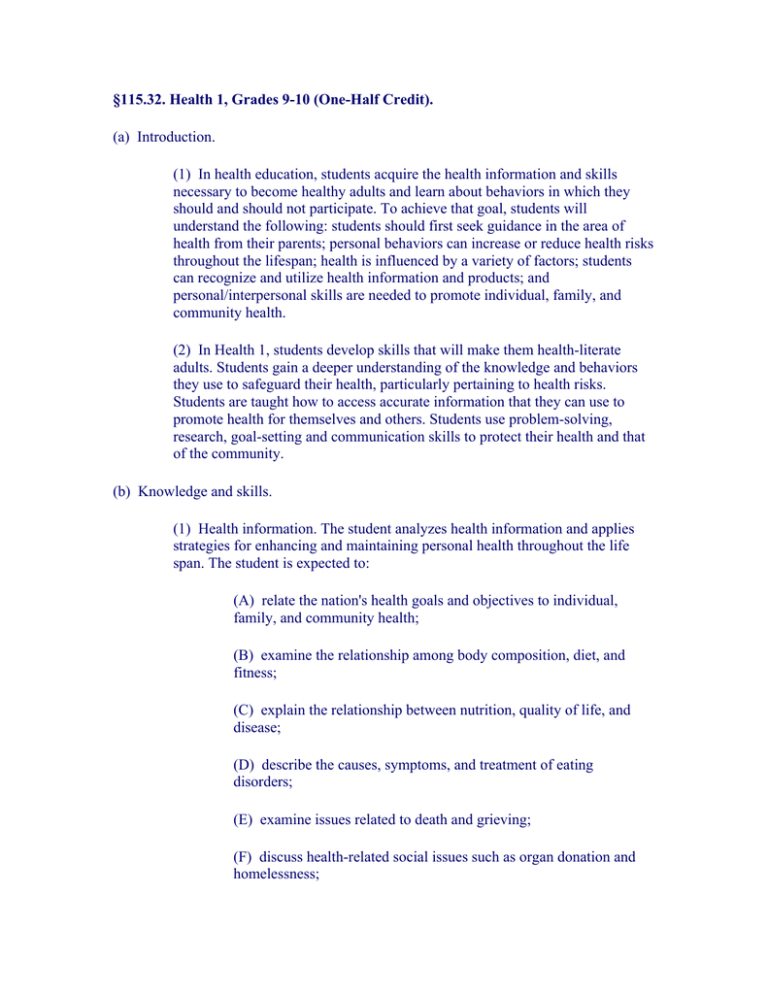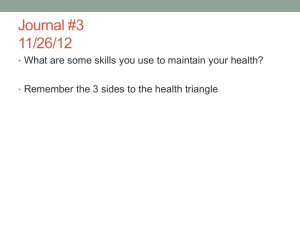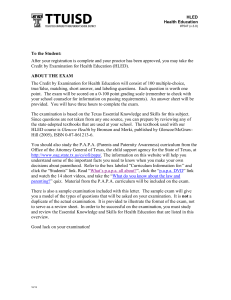
§115.32. Health 1, Grades 9-10 (One-Half Credit).
(a) Introduction.
(1) In health education, students acquire the health information and skills
necessary to become healthy adults and learn about behaviors in which they
should and should not participate. To achieve that goal, students will
understand the following: students should first seek guidance in the area of
health from their parents; personal behaviors can increase or reduce health risks
throughout the lifespan; health is influenced by a variety of factors; students
can recognize and utilize health information and products; and
personal/interpersonal skills are needed to promote individual, family, and
community health.
(2) In Health 1, students develop skills that will make them health-literate
adults. Students gain a deeper understanding of the knowledge and behaviors
they use to safeguard their health, particularly pertaining to health risks.
Students are taught how to access accurate information that they can use to
promote health for themselves and others. Students use problem-solving,
research, goal-setting and communication skills to protect their health and that
of the community.
(b) Knowledge and skills.
(1) Health information. The student analyzes health information and applies
strategies for enhancing and maintaining personal health throughout the life
span. The student is expected to:
(A) relate the nation's health goals and objectives to individual,
family, and community health;
(B) examine the relationship among body composition, diet, and
fitness;
(C) explain the relationship between nutrition, quality of life, and
disease;
(D) describe the causes, symptoms, and treatment of eating
disorders;
(E) examine issues related to death and grieving;
(F) discuss health-related social issues such as organ donation and
homelessness;
(G) analyze strategies to prevent suicides;
(H) examine causes and effects of stress and develop strategies for
managing stress and coping with anxiety and depression; and
(I) describe the importance of taking responsibility for establishing
and implementing health maintenance for individuals and family
members of all ages.
(2) Health information. The student is health literate in disease prevention and
health promotion throughout the life span. The student is expected to:
(A) analyze the relationship between health promotion and disease
prevention;
(B) analyze the influence of laws, policies, and practices on healthrelated issues including those related to disease prevention;
(C) identify, describe, and assess available health-related services in
the community that relate to disease prevention and health
promotion; and
(D) develop and analyze strategies related to the prevention of
communicable and non-communicable diseases.
(3) Health information. The student recognizes the importance and
significance of the reproductive process as it relates to the health of future
generations. The student is expected to:
(A) explain fetal development from conception through pregnancy
and birth;
(B) explain the importance of the role of prenatal care and proper
nutrition in promoting optimal health for both the baby and the
mother such as breast feeding;
(C) analyze the harmful effects of certain substances on the fetus
such as alcohol, tobacco, other drugs, and environmental hazards
such as lead; and
(D) explain the significance of genetics and its role in fetal
development.
(4) Health information. The student investigates and evaluates the impact of
media and technology on individual, family, community, and world health. The
student is expected to:
(A) analyze the health messages delivered through media and
technology; and
(B) explain how technology has impacted the health status of
individuals, families, communities, and the world.
(5) Health information. The student understands how to evaluate health
information for appropriateness. The student is expected to:
(A) develop evaluation criteria for health information;
(B) demonstrate ways to utilize criteria to evaluate health
information for appropriateness;
(C) discuss the legal implications regarding sexual activity as it
relates to minor persons; and
(D) demonstrate decision-making skills based on health information.
(6) Health behaviors. The student assesses the relationship between body
structure and function and personal health throughout the life span. The student
is expected to:
(A) examine the effects of health behaviors on body systems;
(B) relate the importance of early detection and warning signs that
prompt individuals of all ages to seek health care; and
(C) appraise the significance of body changes occurring during
adolescence.
(7) Health behaviors. The student analyzes the relationship between unsafe
behaviors and personal health and develops strategies to promote resiliency
throughout the life span. The student is expected to:
(A) analyze the harmful effects of alcohol, tobacco, drugs, and other
substances such as physical, mental, social, and legal consequences;
(B) explain the relationship between alcohol, tobacco, and other
drugs and other substances used by adolescents and the role these
substances play in unsafe situations such as Human
Immunodeficiency Virus (HIV)/Sexually Transmitted Disease (STD),
unplanned pregnancies, and motor vehicle accidents;
(C) develop strategies for preventing use of tobacco, alcohol, and
other addictive substances;
(D) analyze the importance of alternatives to drug and substance use;
(E) analyze and apply strategies for avoiding violence, gangs,
weapons, and drugs;
(F) analyze strategies for preventing and responding to deliberate
and accidental injuries;
(G) analyze the relationship between the use of refusal skills and the
avoidance of unsafe situations such as sexual abstinence;
(H) analyze the importance and benefits of abstinence as it relates to
emotional health and the prevention of pregnancy and sexuallytransmitted diseases;
(I) analyze the effectiveness and ineffectiveness of barrier protection
and other contraceptive methods including the prevention of Sexually
Transmitted Diseases (STDs), keeping in mind the effectiveness of
remaining abstinent until marriage;
(J) analyze the importance of healthy strategies that prevent physical,
sexual, and emotional abuse such as date rape;
(K) analyze the importance of abstinence from sexual activity as the
preferred choice of behavior in relationship to all sexual activity for
unmarried persons of school age; and
(L) discuss abstinence from sexual activity as the only method that is
100% effective in preventing pregnancy, sexually transmitted
diseases, and the sexual transmission of HIV or acquired immune
deficiency syndrome, and the emotional trauma associated with
adolescent sexual activity.
(8) Influencing factors. The student analyzes the effect of relationships on
health behaviors. The student is expected to:
(A) evaluate positive and negative effects of various relationships on
physical and emotional health such as peers, family, and friends; and
(B) explain the benefits of positive relationships among community
health professionals in promoting a healthy community.
(9) Influencing factors. The student differentiates between positive and
negative family influences. The student is expected to:
(A) describe the roles of parents, grandparents, and other family
members in promoting a healthy family; and
(B) analyze the dynamics of family roles and responsibilities relating
to health behavior.
(10) Influencing factors. The student evaluates the effect of a variety of
environmental factors on community and world health. The student is expected
to:
(A) assess the impact of population and economy on community and
world health;
(B) analyze the impact of the availability of health services in the
community and the world; and
(C) describe a variety of community and world environmental
protection programs.
(11) Influencing factors. The student understands how to access school and
community health services for people of all ages. The student is expected to:
(A) research various school and community health services for
people of all ages such as vision and hearing screenings and
immunization programs; and
(B) compare and analyze the cost, availability, and accessibility of
health services for people of all ages.
(12) Influencing factors. The student understands situations in which people of
all ages require professional health services. The student is expected to:
(A) identify situations requiring professional health services for
people of all ages such as primary, preventive, and emergency care;
and
(B) explain how to access health services for people of all ages.
(13) Personal/interpersonal skills. The student analyzes, designs, and evaluates
communication skills for building and maintaining healthy relationships
throughout the life span. The student is expected to:
(A) demonstrate communication skills in building and maintaining
healthy relationships;
(B) distinguish between a dating relationship and a marriage;
(C) analyze behavior in a dating relationship that will enhance the
dignity, respect, and responsibility relating to marriage;
(D) evaluate the effectiveness of conflict resolution techniques in
various situations;
(E) demonstrate refusal strategies;
(F) explore methods for addressing critical-health issues; and
(G) evaluate the dynamics of social groups.
(14) Personal/interpersonal skills. The student analyzes, designs, and evaluates
strategies for expressing needs, wants, and emotions in healthy ways. The
student is expected to:
(A) demonstrate strategies for communicating needs, wants, and
emotions;
(B) examine the legal and ethical ramifications of unacceptable
behaviors such as harassment, acquaintance rape, and sexual abuse;
and
(C) communicate the importance of practicing abstinence.
(15) Personal/interpersonal skills. The student appraises communication skills
that show consideration and respect for self, family, friends, and others. The
student is expected to:
(A) apply communication skills that demonstrate consideration and
respect for self, family, and others;
(B) demonstrate empathy towards others; and
(C) analyze ways to show disapproval of inconsiderate and
disrespectful behavior.
(16) Personal/interpersonal skills. The student synthesizes information and
applies critical-thinking, decision-making, and problem-solving skills for
making health-promoting decisions throughout the life span. The student is
expected to:
(A) identify decision-making skills that promote individual, family,
and community health;
(B) summarize the advantages of seeking advice and feedback
regarding the use of decision-making and problem-solving skills;
(C) classify forms of communication such as passive, aggressive, or
assertive; and
(D) associate risk-taking with consequences such as drinking and
driving.
(17) Personal/interpersonal skills. The student applies strategies for advocating
and evaluating outcomes for health issues. The student is expected to:
(A) research information about a personal health concern;
(B) demonstrate knowledge about personal and family health
concerns; and
(C) develop strategies to evaluate information relating to a variety of
critical health issues.
Source: The provisions of this §115.32 adopted to be effective September 1, 1998, 22
TexReg 7740.
§115.33. Advanced Health, Grades 11-12 (One-Half Credit).
(a) General requirements. The recommended prerequisite for this course is Health I.
(b) Introduction.
(1) In health education, students acquire the health information and skills
necessary to become healthy adults and learn about behaviors in which they
should and should not participate. To achieve that goal, students will
understand the following: students should first seek guidance in the area of
health from their parents; personal behaviors can increase or reduce health risks
throughout the lifespan; health is influenced by a variety of factors; students
can recognize and utilize health information and products; and
personal/interpersonal skills are needed to promote individual, family, and
community health.
(2) In Advanced Health, students are provided opportunities for researching,
discussing, and analyzing health issues. This higher level of involvement
provides students with experiences designed to reinforce positive health
behaviors. Students are given the opportunity to learn more about technology,
how it affects health, and how to use electronic technology to gain health
information. The emphasis in this course is less related to learning facts and
more related to providing students with the skills necessary to access their own
health information and services and become health literate.
(c) Knowledge and skills.
(1) Health information. The student applies technology to analyze and appraise
personal health. The student is expected to:
(A) generate a personal-health profile using appropriate technology
such as stress reduction, body fat composition, and nutritional
analysis; and
(B) explain how technology can influence health.
(2) Health information. The student researches and analyzes information in the
management of health promotion and disease prevention. The student is
expected to:
(A) investigate various sources in the community that promote health
and prevent disease; and
(B) design health promotion materials.
(3) Health information. The student investigates the importance and
significance of the reproductive process as it relates to the health of future
generations. The student is expected to:
(A) analyze problems during various stages of fetal development;
(B) investigate the role of prenatal care and proper nutrition in
promoting optimal health for both the baby and the mother such as
breast feeding;
(C) describe the harmful effects of certain substances on the fetus
such as alcohol, tobacco, environmental hazards such as lead, and
other drugs;
(D) analyze roles of relationships and responsibilities relating to
marriage; and
(E) analyze behavior in romantic relationships that enhance dignity,
respect, and responsibility.
(4) Health information. The student evaluates the validity of health
information. The student is expected to:
(A) research current health-related standards related to health
information and products from valid sources such as the Centers for
Disease Control and Prevention and the Food and Drug
Administration;
(B) analyze health information based on health-related standards;
and
(C) evaluate the impact of laws relating to the use of medication,
alcohol, tobacco, and other drugs/substances.
(5) Health information. The student describes the effect of marketing and
advertising on health behavior. The student is expected to:
(A) analyze marketing and advertising techniques in health-product
and service promotion; and
(B) apply marketing and advertising techniques to health promotion.
(6) Health information. The student evaluates and utilizes communication
skills in building and maintaining healthy relationships. The student is expected
to:
(A) apply effective communication skills for building and
maintaining healthy relationships;
(B) design strategies for implementing effective conflict
resolution/mediation strategies; and
(C) present a model for effective communication skills.
(7) Health behaviors. The student generates strategies that address health-risk
behaviors. The student is expected to:
(A) participate in school-related efforts to address health-risk
behaviors;
(B) develop a plan to participate in community efforts to address
health-risk behaviors;
(C) develop educational-safety models for children and adults for use
at home, school, and in the community;
(D) evaluate the impact of laws relating to tobacco, alcohol, drugs
and other substances;
(E) investigate treatment plans for drug addiction; and
(F) describe the interrelatedness of alcohol and other drugs to health
problems such as drugs and date rape, Human Immunodeficiency
Virus (HIV)/Sexually Transmitted Disease (STD), and drinking and
driving.
(8) Influencing factors. The student researches and evaluates a variety of
environmental factors that impact personal and community health. The student
is expected to:
(A) analyze the impact of environmental factors such as air, water, or
noise on the health of the community such as air pollution affecting
asthma and drought conditions affecting water supplies;
(B) formulate strategies for combating environmental factors that
have a detrimental effect on the health of a community; and
(C) develop strategies for aiding in the implementation of a
community environmental health plan.
(9) Influencing factors. The student assesses the impact of the economy on
community and world health. The student is expected to:
(A) relate economic status to availability of health services within
the community; and
(B) analyze health care costs of various health services in different
countries.
(10) Influencing factors. The student recognizes the importance of personal
contributions to the health of the community. The student is expected to:
(A) research and/or participate in community health programs that
benefit various populations such as volunteering for teen health lines
and volunteering in nursing homes; and
(B) participate in a presentation to educate others about a variety of
health issues such as panel discussions and role plays or skits to
inform younger students about the dangers of drug use or smoking.
(11) Influencing factors. The student understands issues related to community
health services. The student is expected to:
(A) analyze how the cost, availability, and accessibility of healthcare services affects the community; and
(B) evaluate how the selection of health care services, products, and
information affects the community.
(12) Influencing factors. The student investigates technological advances in the
community that impact the health of individuals, families, and communities.
The student is expected to:
(A) describe technological advances available in the community that
treat health problems such as medical procedures at local hospitals
for treating heart disease and cancer; and
(B) locate health care facilities at which members of the community
can obtain medical care.
(13) Personal/interpersonal skills. The student analyzes, designs, and evaluates
strategies for expressing needs, wants, and emotions in healthy ways. The
student is expected to:
(A) create and apply strategies for communicating emotions, needs,
and wants;
(B) demonstrate leadership skills for advocating health;
(C) investigate and summarize current laws relating to unacceptable
behaviors such as harassment, acquaintance and statutory rape, and
sexual abuse; and
(D) create strategies that promote the advantages of abstinence.
(14) Personal/interpersonal skills. The student evaluates communication skills
that show consideration and respect for self, family, friends, and others. The
student is expected to:
(A) appraise effective communication skills that demonstrate
consideration and respect for self, family, and others;
(B) associate effective communication with success in school and the
workplace;
(C) explain the detrimental effects of inconsiderate and disrespectful
behavior;
(D) apply criteria for using passive, aggressive, and assertive
communication in relationships;
(E) analyze the importance of abstinence from sexual activity as the
preferred choice of behavior in relationship to all sexual activity for
unmarried persons of school age; and
(F) discuss abstinence from sexual activity as the only method that is
100% effective in preventing pregnancy, sexually transmitted
diseases, and the sexual transmission of HIV or acquired immune
deficiency syndrome, and the emotional trauma associated with
adolescent sexual activity.
(15) Personal/interpersonal skills. The student synthesizes information and
applies strategies for making health-promoting decisions. The student is
expected to:
(A) apply decision-making skills to health-promoting decisions;
(B) interpret information provided by parents and other adults; and
(C) determine causal connections that promote health in
relationships.
(16) Personal/interpersonal skills. The student applies strategies for advocating
and evaluating outcomes for health issues. The student is expected to:
(A) research information regarding personal and family health
concerns;
(B) design materials for health advocacy; and
(C) apply the concept of research and evaluation for determining
health information for special populations.
Source: The provisions of this §115.33 adopted to be effective September 1, 1998, 22
TexReg 7740.



